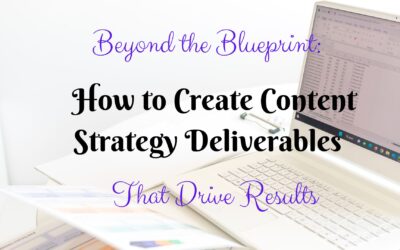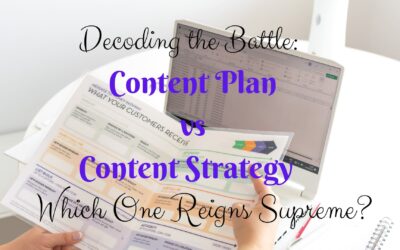Taking into consideration the laser speed development of technology, everything else that’s pegged on it has no choice but to move at this breakneck pace. And like most things in this attention economy, the most effective and popular types of content are rapidly changing, led by the current visual marketing statistics.
With the constant updates, changes in algorithms, and newer techniques, digital marketers continue with the scramble to keep up. Staying updated on emerging trends is very important, however, there is something better than catching a trend just as it emerges, and that is being able to predict it.
As much as trends don’t have a particular pattern they follow, knowing a trend that has been popular helps greatly in making decisions going forward. And this supports a marketer gain some traction and visibility as they direct their future marketing efforts.
Invest In Your Business
Your Content Strategy Doesn’t Deliver the Expected Results?
With this in mind, it’s important to note that visual content (use of images, graphics, videos, and other multimedia content) has been a rising and leading trend in the past years. As 49% of marketers rate visuals as very important, and 13 % sustain it is paramount for their marketing strategy. And 26.2% said that they expected to spend between 21% and 30% of their marketing budget on visual creation. Finally, why not?
Plus, studies have shown that people remember up to 65% of visual content even 3 days later after consuming it, compared to 10% of written content read. A first impression is formed in 50 milliseconds and 81% of online users skim content. (Websiteplanet)
Going forward to 2023, this trend continues to be popular; so, before looking at these trends, here are six reasons your business will need to emphasize visual content marketing.
The 3 Main Types of Visual Content
Before diving into the statistics, here is a quick glance at the main types of visual content that can help your efforts go viral if properly used. Keep in mind that different types of visuals will work differently for various businesses. But here are the 3 main types:
a. Infographics
Infographics are large data made simple and easy to digest through the use of charts, graphs, or visual stories. It is precise because of this aspect of crystalizing large data into digestible bits that makes it very attractive and effective.
b. Images and Photos Mainly Used on Social Media
Eye-catching photos and images are a great way to put a personality to a brand and make it more relatable. They can be used to show your products or brand to your target audience. The key thing is to ensure that the images and photos you use reflect the exact message you want your audience to see.
c. Videos
Videos are something that offers voice to your marketing campaigns. As will be seen in statistics, this visual method is very effective because of its capacity to capture and retain viewers’ attention, when other types of content fail.
Other types of visual content include memes and gifs.
With this understanding of why visual content is the way to go, here are some top visual content statistics in 2023.
Top Visual Marketing Statistics in 2023
Isn’t it just impossible to fathom a world without visuals? Here are the most relevant visual marketing statistics for 2023 in this end-to-end customer experience approach.
General Visual Marketing Statistics
- The visual online information multiplied by 9900% since 2007. (Neomam)
- 59% of marketers use video, 46% use images, and 45% use infographics in their content marketing strategy. (HubSpot)
- More than half of marketers spent at least five hours a week creating visual content (Venngage).
- As said earlier, people are able to remember 65% of any visual content they’ve seen up to 3 days later and only 10 % of textual content they have read.
- 50.5% of marketers said visual content is very important in their marketing strategy, 22.4% that it is quite important, and 13.1% that their strategy is worthless without visuals. (Venngage)
- 28% of marketing experts expect that 71-80% of businesses rely greatly on visuals in 2022.
- Visuals increase the viewer’s desire to read by up to 80%
Visual Marketing Statistics – Video Statistics
- 88% of people are more likely to purchase a product after watching a video and 96% have watched an explainer video to find out more details about a product.
- People watch on average 19 hours of video weekly.
- Short-form video is the most effective type of media sustain 85% of marketers. Instagram Reels and TikTok experience the fastest growth. (HubSpot)
- 69% of marketers expect to spend more on video creation. (Content Marketing Institute)
- Video produced the best results for 38% of marketers last year. (Content Marketing Institute)
- YouTube is the leading source of video content globally, with 1 billion hours viewed on a daily basis and about 5 billion videos being watched each day. Simply mind-blowing. (Comparitech)
- 10 billion views and counting for the most viewed video on Youtube.
- Social media is the preferred marketing channel for marketers. (HubSpot)
- 92% of marketers consider video as an “important” chunk of their marketing and 94% say videos helped increase brand awareness (Wyzowl)
- 79% of non-video marketers plan to use it starting in 2022.
- Companies use a variety of video types, 16% use principally screen-recorded videos, 43% emphasize live-action videos, and 33% prioritize animated videos.
- Video has assisted in boosting user understanding of brands, products, or services, 94% of video marketers said. (Wyzowl)
- Another 87% said that video has helped increase traffic to their websites.
- 82% of video marketers sustain that the use of video has increased the amount of time users spend on their websites. (Wyzowl)
- 86% of video marketers admit that videos helped them increase the leads number and 81% say videos helped them expand direct sales.
- The presence of videos in emails amplifies the click-through by 80% and multiples 30 times the chances of convincing a user to make a payment.
Main Visual Infographic Statistics
One way to get people to look at statistics is to present them in a visually appealing and engaging style. Skim reading is not a new thing; about 80% of readers actually just skim through content and you’re probably skimming through this right now. So, infographics just enable a reader to grasp the data more quickly and in a relatable fun way. So, here are some infographic statistics for 2023 to consider:
- The data visualization industry is poised for sustained growth over the next years, reaching 5.17 billion by 2026. (Demandsage)
- The content strategy of more than 60% of businesses includes infographics.
- Colored infographics convey a high motivational factor (80%).
- People tend to grasp statistics put in graph form better and faster as opposed to pure text according to a study by eye-monitoring research.
- 67% of B2B content marketers use infographics.
- The information presented in an infographic may be processed 60 times faster than reading the equivalent text.
- This study by Springer Link found that illustrations such as graphs aid learning material by up to 323% compared to not illustrated text.
- Infographics get shared three times more on social media compared with any other content type.
Invest In Your Business
Your Content Strategy Doesn’t Deliver the Expected Results?
Visual Content Statistics on Photos and Images Used on Social Media
- Yearly, 1.81 trillion photos are taken, or about 5 billion a day. (Photutorial)
- Google Image Search has indexed about 138 billion images as of 2023 and this number is expected to reach 382 billion by the end of the decade. (Photutorial)
- Venngage research of 2021 indicated that the most used form of visuals were stock images for 33.6% of marketers and original graphics (infographics and illustrations) for 36.4% of them.
- 46% of marketers consider photography as being critical for their marketing. (HubSpot)
- 40% of content creators approve that original visuals are responsible for the highest engagement. (Visme)
- 27.9% of Google search results display image results. (Demandsage)
- Blogs with a high number of visuals tend to perform better, bloggers say. (Orbit Media)
- On a daily basis, users share 1.3 billion photos on Instagram, 2.1 on Facebook, and 3.8 on Snapchat
- Posts with images on Facebook get twice more engagement as those without
- Pinterest, another social network that relies heavily on visuals indicates that 88% of users purchased a product they pinned.
- On Linkedin Posts including 8 images perform best. (OkDork)
- Stock photos databases gather hundreds of millions of images: Shutterstock – 400 million, Adobe Stock – 295 million, Alamy – 288 million.
Besides the three main types of visual content listed above, there are some emerging trends that must be taken into consideration. Here are some related statistics.
Visual Content Statistics on Emerging Trends
· People who use VR to view how-to videos have a 36% chance of remembering more stuff than people who only watched it on YouTube.
· 29% of users said they prefer viewing videos in 360 degrees as opposed to the old traditional way.
· About 90% of adult users consume content from many devices simultaneously.
· 57% of marketers are using live video for campaigns
· The Healthcare industry, gaming, and education are the top 3 industries that are focusing more on VR technology for growth.
Here are a few other visual content statistics:
Which type of visual content was used more frequently?
· Charts and infographics are mainly used for complex sets of data; big firms like Netflix and Google use them more.
· Memes and Gifs are very popular, especially on social media, and were used often by 3.6% of marketers.
· Stock photos with high resolutions were used by up to 40% of the marketers, while another 36% opted to use their original photos.
Which type engaged the users most?
Original graphics such as original infographic data were the best performer at 40%, followed by videos and live presentations at 23% and charts and data visualizations at 20%. Gifs and memes came last with only 5%.
What was the average time spent by marketers weekly to create visual content marketing?
On average, 37% of marketers said they spent between 2-5 hours; another 35% spent less than 2 hours creating visuals. Only 9% of marketers spent more than 15 hours creating visual content.
How much of the budget was spent on visual content creation?
26.2% of marketers expend to spend between 2%1 and 30% of their budget on visual content production and 25.2% of marketers expect to spend less than 10% of their budget on visuals (Venngage). But as this trend gets more popular, the cost of visual production will keep going lower and lower because new technologies come to the rescue and allow producing visuals faster and with fewer expenses.
What’s the number of businesses that are likely to rely heavily on visual content for marketing in 2023?
More than 80% of businesses will rely on visual content marketing according to 45% of marketers. Following 42% of marketers predict that 51-80% of businesses will rely on visual content, the rest think that less than 50% of businesses will require visual content in their marketing campaigns.
The Importance of Visual Content
i. Visual Content Marketing Increases Conversions
Implementing a well-thought-out visual content marketing strategy can increase sales and generate more leads. Statistics show that 84% (Wyzowl, 2021) of consumers said that they were convinced to purchase by a video. As such, it is clear why more and more brands are using visual content in their marketing strategy.
ii. Boosts Brand Recognition
The Social Science Research Network found that 65% of people learn better through visuals. They resonate better with images, videos, memes, and other visuals than text. So, when you incorporate visuals in your marketing strategy, you automatically boost your brand image because people will easily remember you and associate your brand with what they see.
iii. More Engagement
Another statistic by Brightcove said that videos drive user engagement by up to 53% and 66% of millennials engage with brands after viewing their video content on social media.
These consumers eventually share more video content than text content, consequently increasing engagement.
iv. Better ROI
That visual content is effective is no secret. 86% of businesses count on video as a marketing powerful tool, while 92% of marketers rank it as “important” in their overall marketing strategy. Moreover, 86% of markers sustain that they generated more leads with video, and 81% directly increased sales.
What these visual statistics show is that your brand is able to engage better with the consumers, and also retain their attention and get a response.
v. Enables Visual Search
Sometimes words may fail you while trying to describe something and this is where visual search comes in. It uses real pictures instead of keywords to search for other exact or similar images.
A study found that millennials are the early adopters of visual search shopping, so as this trend accelerates, your business should stay ahead of this advanced search method because it’s more accurate and it will only get better. And in the end, it will drive you sales.
Valuable Takeaways
From the visual marketing statistics for 2023 listed above, it’s clear that most marketers consider the use of graphics as critical in their campaigns. Most marketers today are using these various types of visual content for their campaigns and creating budgets for them. Business websites and social media sites attract more customers and retain their attention more when visual content is used.
Statistics on visual learning show that the use of VR is getting more popular and has better engagement rates as compared to common videos, however, with that said, pre-produced videos and live streams are getting more popular by the day, with greater returns on investment. Most adults are, at any given time, consuming content from multiple devices.
The importance of visual content can therefore not be summarized in one sentence, and with these statistics, you have a broad idea of how 2023 is going to be as far as visual content marketing is concerned and this will give you traction in your future marketing efforts.





